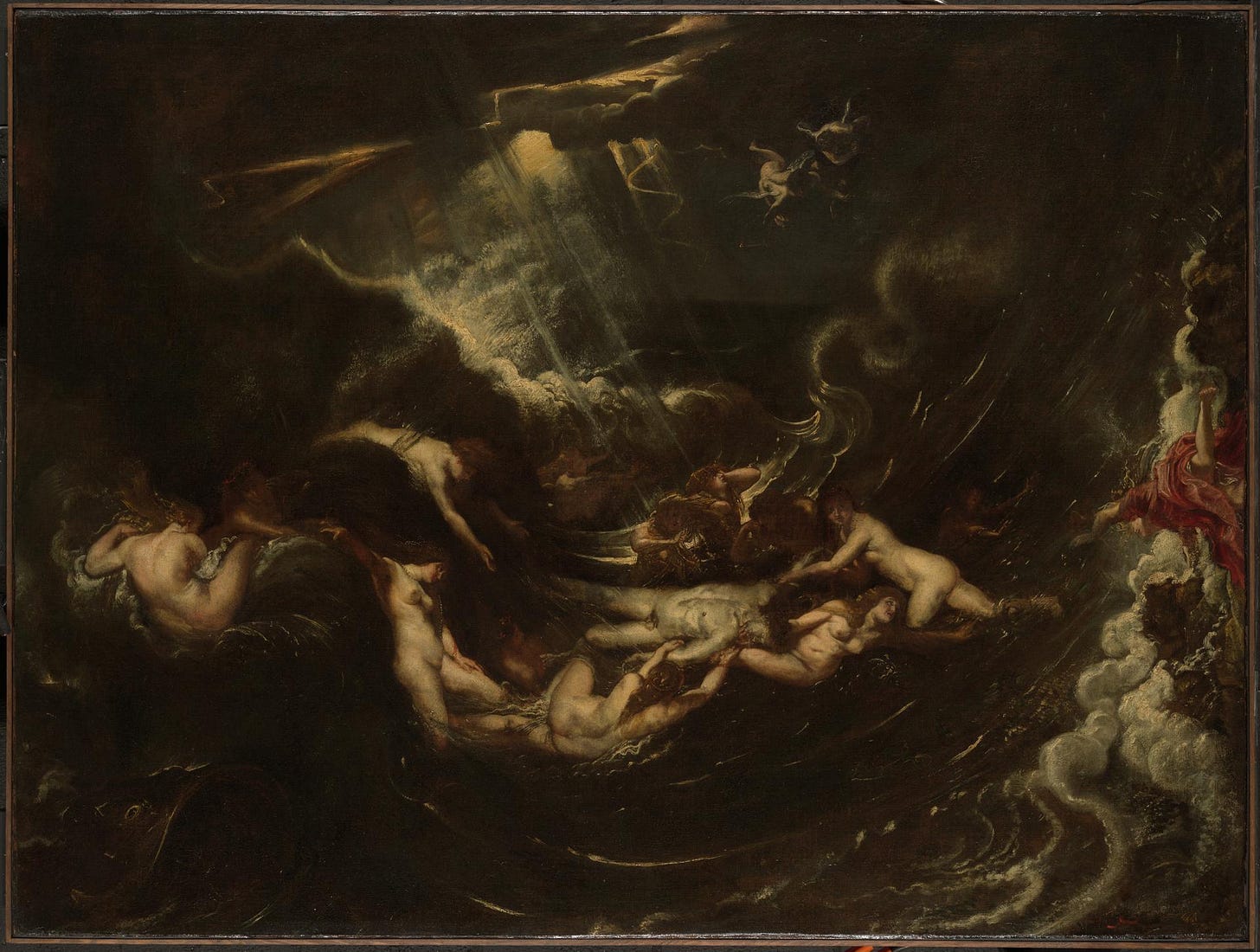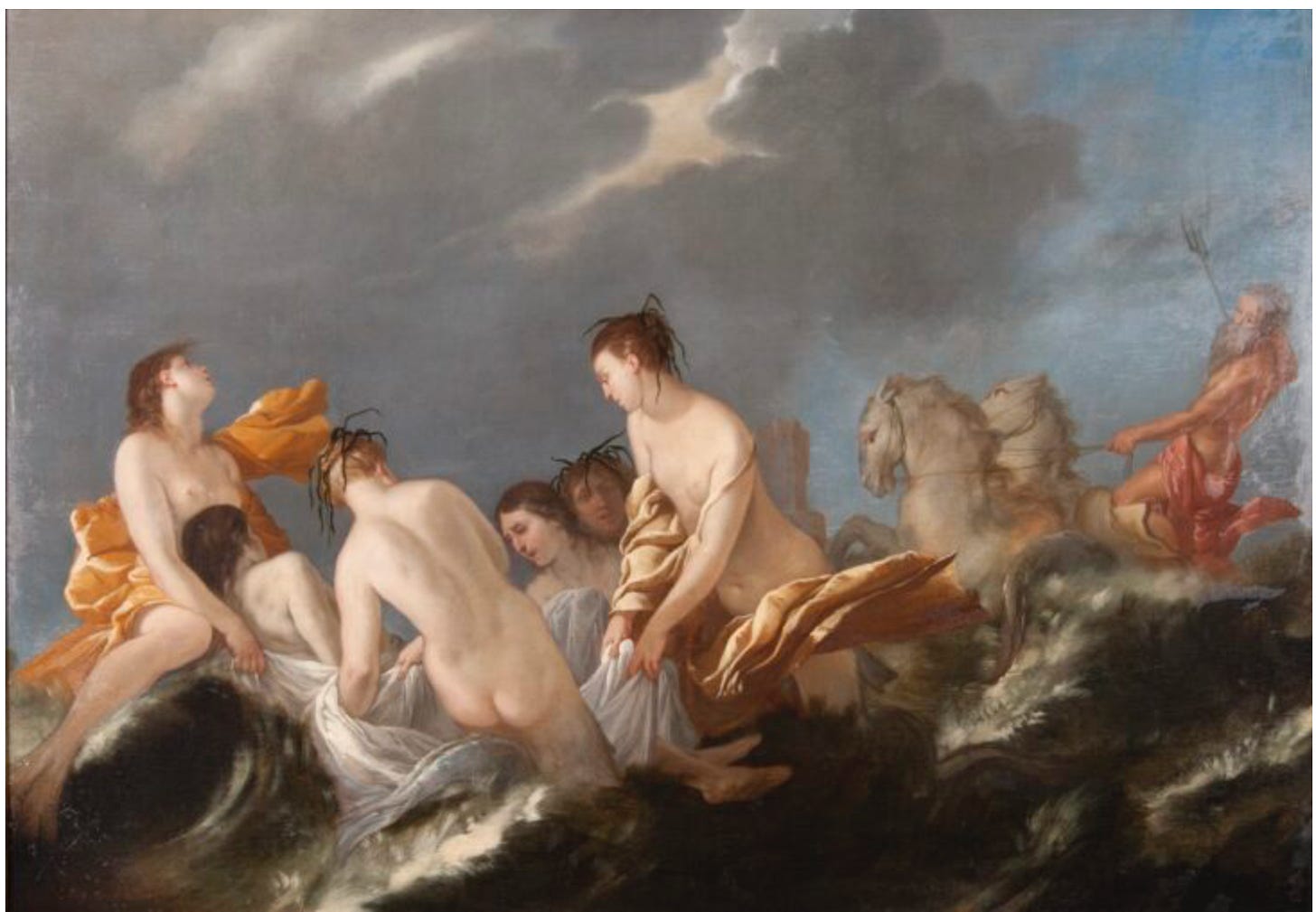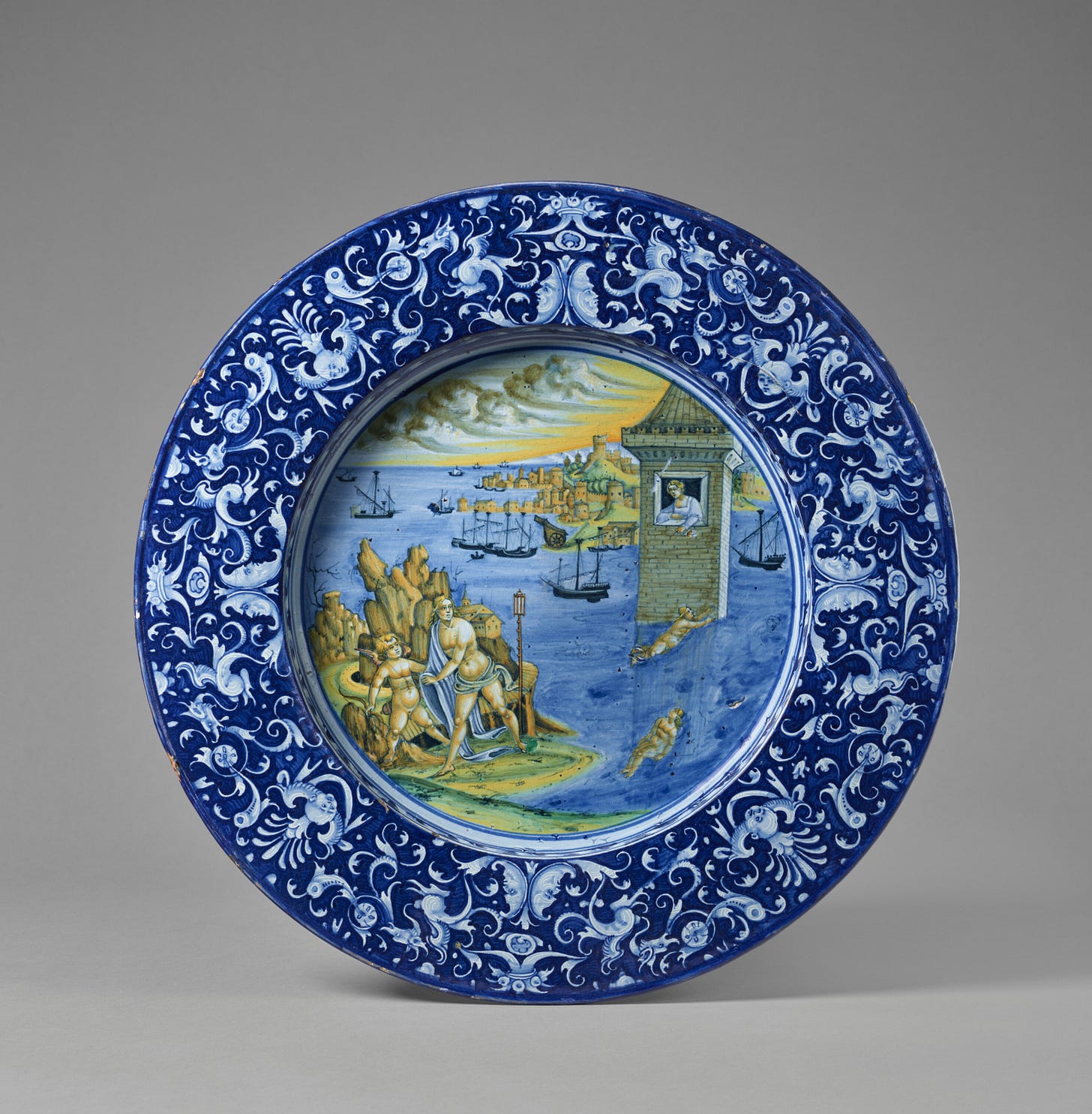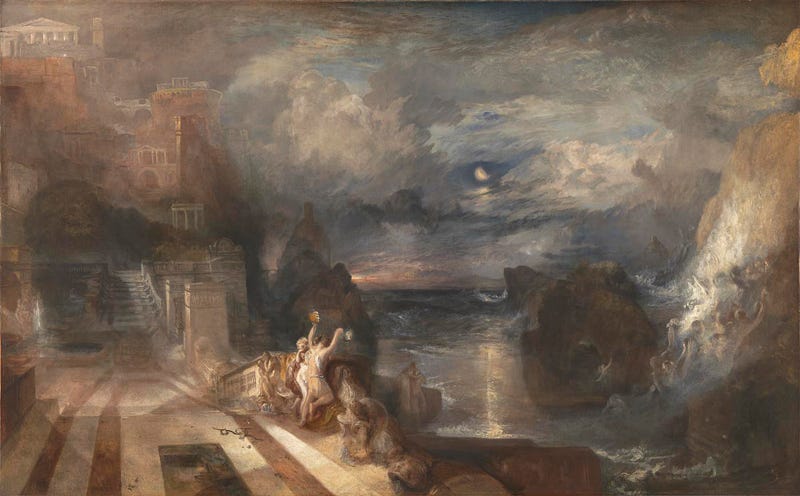Swimming the Hellespont for Love: The Tragic Romance of Hero and Leander
This lesser-known myth about two young lovers separated by a four-mile stretch of sea was even more compelling to early modern artists and critics than it was to the ancient Greeks and Romans
In the early 1800s, Lord Byron—taken as he was with Greece and its cultural legacy—decided it was not enough to simply read the classics: he wanted to live the experience of ancient mythological characters too. And so (as the story goes, anyway), on a spring day, he embarked on a four-mile swim across the Dardanelles, the strip of sea separating Asia from Europe that the ancients called the Hellespont.
Why?
Well, Byron was inspired by the lesser-known Greek myth of Hero and Leander. Hero was a priestess of Aphrodite, and she lived in a tall tower on the European side of the Hellespont. Her beloved was Leander, who lived on the Asian side of the Hellespont, and he made the crossing every night to visit her. Hero would light a lamp in her tower, safely guiding Leander to shore.
But one day tragedy struck: during a storm, the lamp was blown out; in the turbulent waters Leander was unable to see where he was going, and he eventually drowned. Hero was so grief-stricken that she threw herself from the tower.
You’ll recognize several familiar tropes and motifs here that have been popularized in fairytales and other classic literature:
The “princess in the tower” theme, familiar from Rapunzel and Sleeping Beauty
The “star-crossed lovers” theme, familiar from Romeo and Juliet and elsewhere
The tragic deaths of both characters, one after the other (see further Romeo and Juliet as well—some have speculated that Shakespeare was inspired by this myth when writing the play)
This myth was well-known in antiquity, of course, but I wouldn’t say it was on the same level as, for instance, the story of Medea or the legendary exploits of Heracles. But from the Renaissance through the Romantic period, the myth absolutely fascinated artists and writers, who were drawn to the stark tragedy of Hero and Leander’s romance.
First, we’ll look at some literary receptions of the myth, and then turn to art.
First, literature. After he made the four-mile voyage across the Dardanelles, Lord Byron wrote a poem about his experience, titled “Written After Swimming from Sestos to Abydos,” a title that specifically names the places where Leander and Hero hailed from, which is a clue to the reader before you even dive in (pun fully intended) that the work will engage with classical mythology. The poem goes as follows:
If, in the month of dark December,
Leander, who was nightly wont
(What maid will not the tale remember?)
To cross thy stream, broad Hellespont!
If, when the wintry tempest roar'd,
He sped to Hero, nothing loth,
And thus of old thy current pour'd,
Fair Venus! how I pity both!
For me, degenerate modern wretch,
Though in the genial month of May,
My dripping limbs I faintly stretch,
And think I've done a feat today.
But since he cross'd the rapid tide,
According to the doubtful story,
To woo,—and—Lord knows what beside,
And swam for Love, as I for Glory;
'Twere hard to say who fared the best:
Sad mortals! thus the gods still plague you!
He lost his labour, I my jest;
For he was drown'd, and I've the ague.
In the poem, Lord Byron gently pokes fun at himself by starting out with the high drama of Leander’s swims in the coldest months of the year, while he himself chooses to swim in the warmer months—and just once, as opposed to Leander’s nightly cadence.
But at the same time, Byron gently pokes at the myth itself, referring to it as a “doubtful story.” Leander wanted love (or, as Byron alludes to with his line “to woo—and Lord knows what beside,” maybe it was just lust), he wanted glory; it’s up to the reader to decide which is the nobler goal.
Indeed, Byron comes out ahead: Leander loses his life, but Byron “loses his jest" (i.e., joke’s on him) because he gets sick from his icy swim.
After reading Bryon, I wanted to take a look at one of my favorite ancient authors, Ovid, who wrote two fairly long elegiac poems with his own take on the myth: a pair of fictional letters, one written from Leander to Hero, and one written from Hero to Leander in reply. These are part of what is known as his collection of Heroides, epistles from mythological heroines to their beloveds.
In these letters, Leander is hesitant to make the trip when he knows that Boreas, the north wind, is stirring up a storm. At the beginning of his letter, Leander curses the god whom he perceives to be responsible:
at tu, de rapidis immansuetissime uentis,
quid mecum certa proelia mente geris?
in me, si nescis, Borea, non aequora, saeuis:
quid faceres, esset ni tibi notus amor?
tam gelidus quod sis, num te tamen, improbe, quondam
ignibus Actaeis incaluisse negas? (18.37-42)
But you, most savage of the fierce winds, why do you wage war against me, with your mind resolute? You rage against me, if you don’t know, Boreas, not the waters. What would you do, if love were not known to you? As chilly as you are, wicked one, nevertheless, do you deny that you were once enflamed by Actaean fires?
But, in her reply letter, Hero questions Leander’s assessment of the situation, suggesting that it is Leander, not Boreas, who is at the root of the problem:
aut ego cum cara de te nutrice susurro
quaeque tuum miror causa moratur iter,
aut mare prospiciens odioso concita uento
corripio uerbis aequora paene tuis,
aut, ubi saeuitiae paulum grauis unda remisit,
posse quidem sed te nolle uenire queror. (19.19-24)
Either I murmur about you with my dear nurse, and wonder what reason delays your journey, or, looking out over the sea, stirred up by the odious wind, I reprove the waters in words nearly yours, or, when the burdensome wave has relented in its cruelty a little, I lament that you are able to come; you just don’t want to.
The reader senses the dramatic irony of the scene—although no further letters follow, there is no need for them: the reader knows that Leander will be persuaded by Hero’s whining and make the dangerous journey anyway, dying as a result. And, as a result, Hero will die as well.
For my undergraduate thesis, I remember making a case that these two letters were influenced by Greek philosophy, since nature plays such a big role in the tale—is it Boreas’ fault or not? Who controls nature? What is the relationship between man and nature? I don’t think my undergrad thesis advisor bought it, but it’s interesting to think about the philosophical implications of the myth.
You can also read it through an ecocritical lens, since the sea is essentially a character of its own in the story.
For any kind of ecocritical reading of the myth, though, it’s helpful to have something to look at, not just read. So let’s turn to the art.
Sixteenth and seventeenth century artists were evidently quite intrigued by the aesthetics of the stormy sea and the tragic romance that the sea both facilitated and, one fateful day, put a swift end to.
I love this moody take on the story by Peter Paul Rubens:

The pale bodies stand out sharply against the black of the water and the sky. At the center is Leander’s drowned corpse, and a sickly light shines down from above. The female nude figures might normally be considered erotic, but in this context—to me, at least—the tragedy produces less of a romantic aura than a feeling of revulsion and pity.
Here, the sea is a place of chaos and danger, a liminal space (literally) between Leander and Hero that prefigures their separation by death.
But the sea is not always so foreboding in art. In the same century, Carpioni produced his own version of the scene. Note how different the mood is:

The storm itself does not seem to be depicted; the dark clouds are drifting away, and we see blue sky already returning. Leander’s corpse is off to the left, but his face is turned away, and most of his body is concealed. Around him are nymphs of the sea, gently shrouding his body and preparing to take it away. On the right, the sea god Poseidon brandishes his triton, in a gesture that seems to honor the young man’s ultimate sacrifice for love.
In this instance, the sea recognizes Leander’s bravery and devotion, and the ocean provides a final resting place that is worthy of his heroic life.
It seems that artists did not shy away from rendering the scene in upbeat colors, celebrating the exemplum of courtly love that Leander seems to embody. About a century earlier, for example, an unknown maker created this beautiful plate, which shows Leander both swimming to Hero’s tower (I love how the tower seems to be just floating in the ocean) and also as a corpse, drifting back to shore:

You can also see Leander off to the left, preparing to make the swim. But I love the cornflower blue, rich indigo, and gentle orange-yellows of the scene, which gives it a certain tranquility. But here too the ocean is an ambiguous space that both connects and divides the young lovers, and it is maybe not so much a peaceful zone as an unpredictable one, neither hostile nor sympathetic to Leander and, at any rate, unwilling to help him in his hour of need.
I love that this scene is on a plate, of all things. Remember, you’d (maybe—could just be art) eating off this dish, and when the food was gone, then the scene would be revealed. That would be a real conversation-starter at a dinner party!
As we saw with Lord Byron’s poem, the Hero and Leander story was also very popular with the nineteenth century Romantic movement. In this painting here, by Joseph Mallord William Turner, the artist keeps a balance between moodiness and romance, with an almost Impressionistic style and soft colors:

The sea is less prominent here, and the classical architecture of the setting is what really catches the eye. The couple is down on the shore together, and it looks like Leander is about to swim away. If you look closely, it’s a Cupid who is holding up the lamp for them to see by. But it’s the moon that seems to shine more light down on the ocean—not the lovers—maybe highlighting that the water will become Leander’s grave. The soft lighting could be upbeat, but the dark clouds keep the overall tone quite somber.
All together, both artists and writers engaging with this ancient myth focus on the dramatic irony and high tragedy of the story. Is Leander and Heros’ love the main point, or is it overshadowed by their deaths? The works we’ve looked at here keep it ambiguous. We might think of death as the thing that brings life to their story, at least from the perspective of ancient literary critics, who were fascinated by, as Jean-Pierre Vernant famously put it, la belle morte: a hero’s “beautiful death,” which, as many scholars have pointed out, has a strangely aesthetic appeal to it. Maybe it’s the romance or Romance of it all, maybe it’s simply voyeurism, maybe it’s the chance to live out a very dramatic story vicariously through myth. Maybe Leander and Hero’s story is beautiful because it is cut short. This is what myth does—it gives us insight into the extremes of human experience and emotion, but from a distance.
In conclusion: from antiquity to the present, no one can resist a tragic romance, and Hero and Leander is one of the most appealing. Whether you’re into romance, mythology, history, philosophy, ecocriticism, or folklore, this story has something for you.
I hope you enjoyed this week’s essay and would love to hear from you in the comments.
Take care until next time,
MKA



